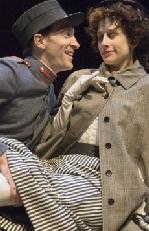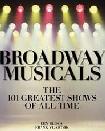SITE GUIDE
SEARCH
REVIEWS
FEATURES
NEWS
Etcetera and
Short Term Listings
LISTINGS
Broadway
Off-Broadway
NYC Restaurants
BOOKS and CDs
OTHER PLACES
Berkshires
London
California
New Jersey
DC
Philadelphia
Elsewhere
QUOTES
TKTS
PLAYWRIGHTS' ALBUMS
LETTERS TO EDITOR
FILM
LINKS
MISCELLANEOUS
Free Updates
Masthead
Writing for Us
A CurtainUp Review
La Ronde
|
A woman like you one does not take before breakfast.
— The Count
|

Ben Dibble and Sarah Sanford
(Photo: Jeffrey Stockbridge) |
Continued Below»
Lantern Theater Company's Artistic director Charles McMahon translated the play himself, a difficult job and surely a labor of love. He also conceived the idea of casting just two actors for ten roles. While the language lends a fresh and current quality to the play, and the production shows off the skills of two very good actors, the gains do not necessarily outweigh the losses. One thing gradually lost is a strong sense of the changing partners who link to form this "round dance" of seduction. Here the two participants repeatedly encounter not new partners, but each other in slightly different guises. The same actors meeting again and again in repeated couplings suggests Warholian multiples more than a chain of lovers.
The theater space, adorned with subtly lighted, rich, red draperies, ornamental lamps, screens, and small pieces of appropriate furniture, hints at the Vienna of the turn of the century-before-last, and recalls for me the once glorious Old Vienna. When I was a child not that long ago and my family lived near Vienna, I was subjected to piano and dance lessons from strict task-masters, and my parents attended the theater and the opera. Post WW II Vienna retained vestiges of the past-- in its old people, in remnants of customs and in venerable ornate buildings that recalled the city's rococo splendor.
In this production, Viennese music enhances scene transitions, which often are lengthy due to on-stage costume changes necessitated by actors who are on stage for all ten scenes. The costumes are elegant and elaborate. Two lean, athletic actors portray their plump Viennese counterparts of the late 1890s. Unusual for the Lantern, the actors come from outside the circle of this theater's usual suspects. Ben Dibble, who was fascinating in Baby Case in '91 and two years later in Bat Boy, won the 2006 F. Otto Haas Award for Emerging Artist. Sarah Sanford of Pig Iron Theatre, a memorable Maya in Hell Meets Henry Halfway in '03, performed in the Live Arts Festival last year.
The pairing of the costumes and manners of a bygone era with updated language subtly shifts the thrust of the work. New irony is added to the play's original irony as the characters participate in the proceedings while seeming to comment on them at the same time, playing for laughs. The comedy created by the collision of a quaint past with a modern idiom makes for a funny show.
Two or three years ago above a pub in Hampstead, London, a shadowy production that used Bentley's translation felt dark and dangerous. The women's repeated protestations and yieldings were amusing as social mores clashed with lust. But the delicate manners of dalliance, because they were taken more seriously, were charged with eroticism. However, in the Lantern's new reading a winking attitude about the coyness of capitulation produces broad comedy, as in each brief contest of propriety vs desire, desire inevitably wins. This comic approach distances us, and works against a portrayal of sensuality.
A single strong nude scene that grounds the play is too modern, matter-of-fact, and bright to feel erotic. Yet, because of the lack of costumes, it counterfeits some sense of the shock that -- at least officially-- scandalized Berlin in 1921.
In addition to the subtle distancing resulting from the language and the heightened comic take, there is another important distancing effect. While having two actors play all ten parts is a valid dramatic choice, it alters our experience of the play. Instead of looking at the characters themselves, we look for nuances the actors employ to distinguish each new character from the last.
Schnitzler once wrote, "To be serious and to be humorous, that's two different things." He referred to his work as comedy, but he seemed to mean ironic. His underlying vision is tragic. As McMahon writes in the director's notes about La Ronde, "We see a series of snapshots from all the different strata of Vienna, which accumulate into a singular picture of its people at one of their favorite pursuits; that of sexual intrigue and the intoxicating clouds of fantasy and romance that attended it. It was their peculiar response to their crumbling world."
McMahon, who is intimately familiar with this play, has taken a risk in offering his fresh approach. This is laudable, and the show certainly is not same-old, same-old. The theater lives and thrives on the energy of new ideas, although not all new approaches will be completely successful.
|
La Ronde
By Arthur Schnitzler Translated by Charles McMahon Directed by Charles McMahon Cast: Ben Dibble, Sarah Sanford Set Design: Meghan Jones Lighting Design: Janet Embree Costume Design: Millie Hiibel Sound Design: Nick Rye Lantern Theater Company at St. Stephen's Theater, 10th and Ludlow Sts. Running time: approx 2 hrs, 15 min including one 12 min intermission 02/02/07— 02/25/07 Reviewed by Kathryn Osenlund based on 02/09/07 performance. |

Easy-on-the budget super gift for yourself and your musical loving friends. Tons of gorgeous pictures.

Leonard Maltin's 2007 Movie Guide

At This Theater
Leonard Maltin's 2005 Movie Guide

 >
>

